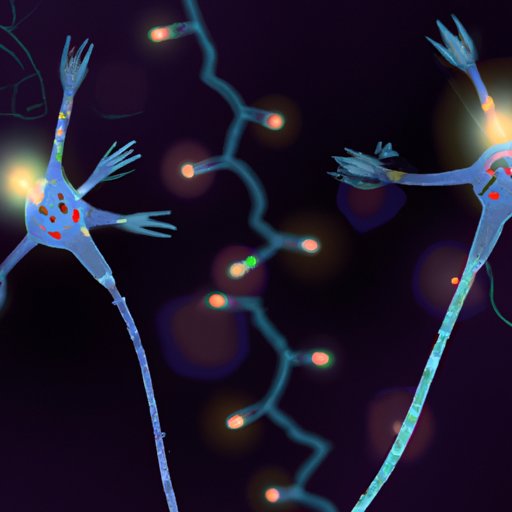Introduction
Neurotransmission is the process by which messages are sent from one neuron to another. This is an essential function for the brain and nervous system, as it allows us to think, move, and react to our environment. In this article, we will explore the steps of the neuronal communication process and explain how messages travel from one neuron to another. We will cover topics such as the anatomy of a neuron, the journey of a message, axons and dendrites, synapses and receptors, and the role of neurotransmitters.

Explaining the Neurotransmission Process: How Messages Travel from One Neuron to Another
Before we can understand how messages travel from one neuron to another, we must first understand the basic anatomy of a neuron. A neuron is made up of several parts, including a cell body, dendrites, and an axon. The cell body contains the nucleus, which houses genetic material, and other organelles. Dendrites are short branches that extend outward from the cell body and receive incoming signals from other neurons. The axon is a long filament that carries signals away from the cell body to other neurons.
The Journey of a Message: A Step-by-Step Guide to Neuronal Communication
Once the message is received by the dendrite, it travels down the axon in the form of an electrical signal. This signal is generated by the movement of ions across the membrane of the neuron. As the signal moves down the axon, it triggers the release of chemicals called neurotransmitters at the end of the axon. These neurotransmitters cross the small gap between two neurons, known as the synaptic gap, and bind to receptors on the receiving neuron.

Connecting the Dots: Understanding the Pathways of Neural Signaling
To understand how messages travel from one neuron to another, it is important to understand the pathways of neural signaling. Axons and dendrites are the main pathways for transmitting signals between neurons. Axons carry signals away from the cell body, while dendrites carry signals toward the cell body. These signals are then transmitted across the synaptic gap, which is the tiny space between two neurons.

Synapses and Signals: An Overview of how Nerve Cells Communicate
The synaptic gap is filled with neurotransmitters, which are small molecules that act as messengers between neurons. There are two types of synapses: chemical and electrical. Chemical synapses use neurotransmitters to send signals across the gap, while electrical synapses use electric current to transmit signals. When a signal reaches the receiving neuron, it binds to receptors on the surface of the neuron, which triggers a response in the receiving neuron.
The Synaptic Gap: Investigating the Role of Neurotransmitters in Neuronal Communication
When a signal reaches the synaptic gap, neurotransmitter molecules are released from the sending neuron. These molecules then cross the gap and bind to receptors on the receiving neuron. Depending on the type of receptor, the signal may trigger a variety of responses in the receiving neuron, such as an electrical signal, a change in gene expression, or the release of a different type of neurotransmitter.
Conclusion
In conclusion, neuronal communication is an intricate process that involves the transmission of electrical and chemical signals between neurons. The journey of a message begins when an electrical signal is triggered in the sending neuron and travels down the axon to the synaptic gap. At the gap, neurotransmitters are released and bind to receptors on the receiving neuron, triggering a response. Ultimately, this process allows us to think, move, and respond to our environment.
(Note: Is this article not meeting your expectations? Do you have knowledge or insights to share? Unlock new opportunities and expand your reach by joining our authors team. Click Registration to join us and share your expertise with our readers.)
